Idaho (original) (raw)

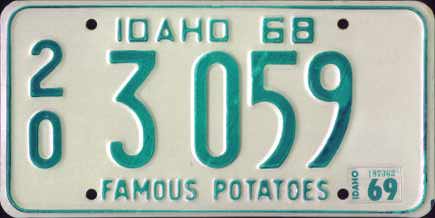 |
Idaho 1969 passenger issue (1968 base). This baseplate was issued in Idaho from 1968 through 1970, and could be valid with stickers through 1976. The format of these plates includes a county code prefix (stacked for two-digit county codes) and numeric serial. Counties were coded by first letter and then numerically, so that the first county alphabetically to start with "B" is given code "1B", the second is "2B", etc. This system is still in use today in the state. Single letter prefixes are used for counties where there is only one county starting with that letter. "2/O" indicates Owyhee county. Click here for a full listing of Idaho county codes. |
|---|---|
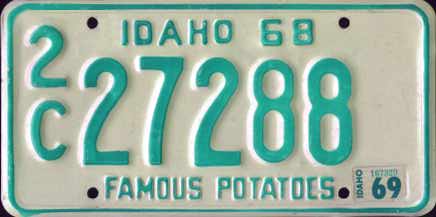 |
Idaho 1969 passenger issue (1968 base). This was a second variation of the 1968 baseplate, using these shorter number dies, no spaces in the serial, and squarer letter dies for the "Famous Potatoes" slogan. This plate was issued in Canyon county, #2C. |
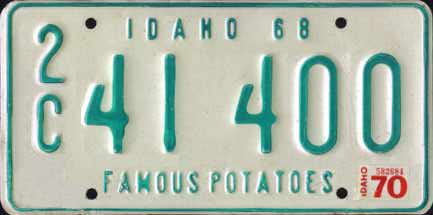 |
Idaho 1970 passenger issue (1968 base). A third variation of the 1968 baseplate, this plate features extremely narrow dies. Apparently there are two die sets used within this variation, one with serif "1"s and closed "4"s and one with a straight "1" and open "4". This is another issue from Canyon county, #2/C. 1970 expirations are rare on this plate due to the start of staggered registrations in the state at the end of 1969. Plates ending in 6 through 0 were issued expirations of June through October, 1970, while plates ending in 1 through 5 were jumped ahead to January through May, 1971, skipping 1970 entirely. |
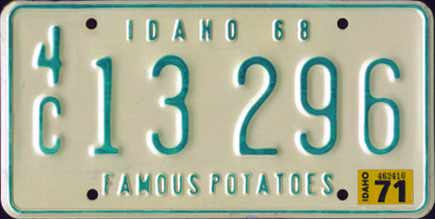 |
Idaho 1971 passenger issue (1968 base). This is the other narrow-die variation, with serif "1" dies and, presumably, closed "4" dies. The "4" die for the county code stayed the same in either case. This plate is from Cassia county, fourth alphabetically in the "C"s. This plate expired in June, 1971, indicated by the last digit of the plate (6) and the year-only sticker. This arrangement for determining the month of expiration was used through 1986. |
 |
Idaho 1971 passenger issue (1968 base). This is the is the fourth variation of the dated "68" baseplate, introducing a die set that would become Idaho's standard dies for the next couple decades. This plate was also issued in Canyon county, indicated by the stacked 2/C. |
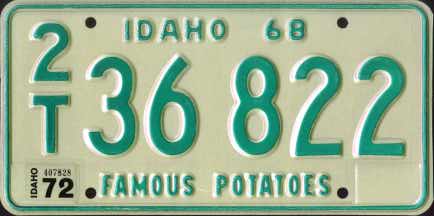 |
Idaho 1972 passenger issue (1968 base). Later plates on this base from some counties added lightly embossed boxes at the bottom corners to indicate sticker placement. This plate was issued in Twin Falls county, code 2/T. |
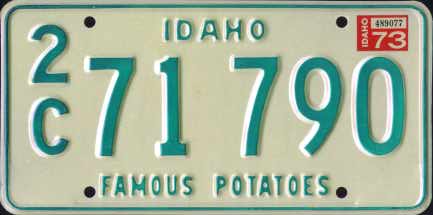 |
Idaho 1973 passenger issue. Starting in 1971, the date was removed from the 1968-series baseplate and the state name was centered at the top. Plates in this format were issued from 1971 through the end of the series in 1973, when a general re-issue occurred (see next). Another plate issued in Canyon county, #2/C. |
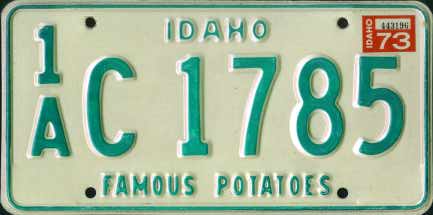 |
Idaho 1973 passenger issue. Another of the undated bases, as some of the larger counties overran their initial all-numeric plates, letter prefixes were established to extend the series beyond 100,000 plates. This plate was issued in Ada county, #1/A. |
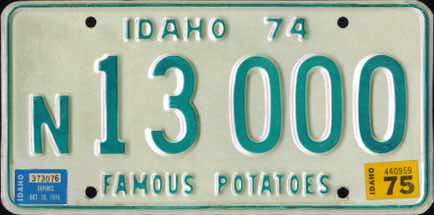 |
Idaho 1975/76 passenger issue (1974 base). In 1974, all vehicles were issued this new dated baseplate, identical to the older base in everything but the embossed date. These dated plates were issued into 1975 and could be used with stickers through the end of 1987. "N" plates indicate NezPerce county, which is the only one starting with N. |
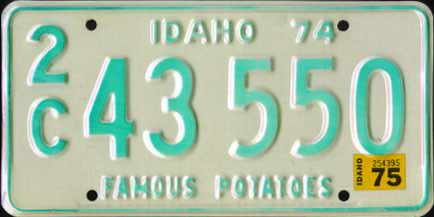 |
Idaho 1975 passenger issue (1974 base). Another 1974-base Idaho plate, this one features an odd offset on the state name and year at the top, which is set off to the right rather than being centered on the plate. I have no idea how common this manufacturing variation is, but it was enough to get me to pick up the plate. This one was issued in Canyon county (2/C) once again and features a lower serial than the 1971 and 1973 issues above from this county, illustrating that each county's serial format restarted at 1 when these plates were introduced in 1974. |
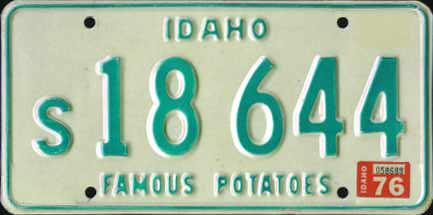 |
Idaho 1976 passenger issue. In 1975, the embossed date was once again removed from the baseplate and the state name was centered again. Plates in this format were issued through the end of this baseplate's life in 1982, and could be revalidated through 1987. This plate was issued in Shoshone county, the only one starting with "S," and also features the first revision (red) 1976 sticker (see next.) |
 |
Idaho 1976 passenger issue. Another natural expiration 1976 plate, with a couple differences to the previous one. This particular plate has two embossed sticker boxes at the bottom of the plate, which were not present on the dated 1974 plate or later undated issues. It also has the blue version of the 1976 validation sticker, showing both the month and year of expiration. This sticker was made necessary due to a lawsuit challenging the validity of using only the last digit of the plate to determine expiration month. Late 1976 and all 1977 stickers spelled out the month and year of expiration, with the year-only sticker reintroduced in 1978, presumably after any necessary modifications to the law. |
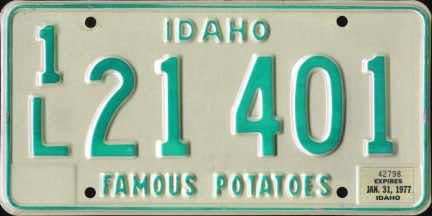 |
Idaho 1977 passenger issue. The 1977 version of the combination month/year sticker was black on white and issued for all expiration months during 1977. This plate also has the raised sticker wells at the bottom corners, found on some but not all issues during this period. This plate was issued in Latah county (#1/L) |
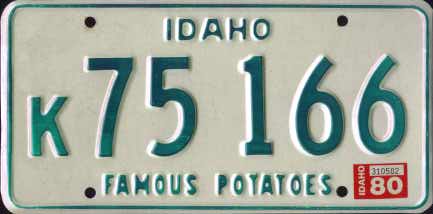 |
Idaho 1980 passenger issue. Continuation of the undated 1976 base, this plate does not feature the two embossed sticker boxes at the bottom of the plate seen on the 1976 and 77 plates above. This plate is from Kootenai county, code "K". |
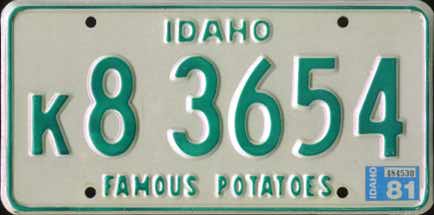 |
Idaho 1981 passenger issue. Another piece of minutia, this one features a slight serial spacing variation seen on these plates. Most plates with five-digit serials were spaced in a "12 345" arrangement, like the ones above, but occasionally the dies were placed in this alternative "1 234" arrangement. This plate also came from Kootenai county, using county code "K". |
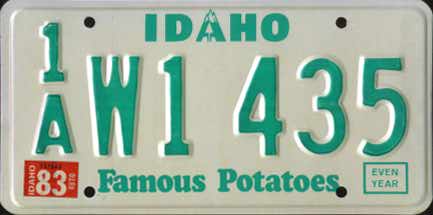 |
Idaho 1983 passenger issue. Starting in 1982, new baseplates were issued with a screened background and a mountain peak serving as the "A" in Idaho. These continued the series of the 1974 plates, and as counties ran out of all-numeric combinations, some counties began issuing plates with a one-alpha prefix as part of the serial. This plate is from Ada county (1/A), which is greater Boise. Blank plates had boxes at the lower corners marked "ODD YEAR" and "EVEN YEAR" to indicate sticker placement. |
 |
Idaho 1985 passenger issue. Continuation of the 1982 screened base, when counties had overrun their allocation of all-numeric and single-alpha plates, two-alpha serials were introduced to extend the series. This was such a double-alpha issue from Ada county. |
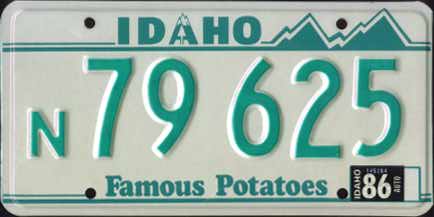 |
Idaho 1986 passenger issue. In 1985, the baseplate was modified once again to include an entire range of mountains to the right of the state name and green lines above and below the serial. These plates again continued the 1983 series and used one- or two-alpha prefixes as needed in larger counties. This is another issue from NezPerce county, code "N". These plates, along with all other green-on-white issues were replaced during 1987. |
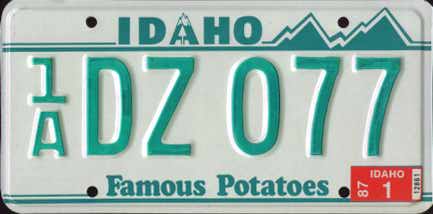 |
Idaho 1987 passenger issue. Same series as above. Starting in late 1985, Idaho discontinued the arrangement of having the month of expiration determined by the last numeric digit of the plate. As a result, stickers from November 86 forward have both the month and year of expiration listed, and the month no longer necessarily corresponds to the last digit of the plate. This is another double-alpha plate from late in the series in Ada county, with these issues again replaced after their 1987 expiration. Smaller dies for stacked county codes were used on these plates to allow the two characters to fit between the green lines on the plate. |
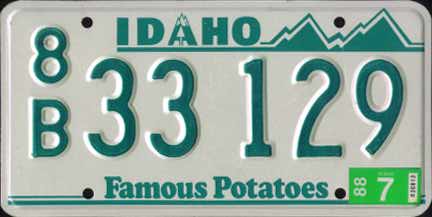 |
Idaho 1988 passenger issue. During 1987, a general re-issue occurred in the state, with all 1974-87 bases replaced by this revised version of the Sawtooth Mountain plate. This plate was identical to the previous graphic aside from the cut-off green line at the top of the plate, which allowed larger-size county code letters to be reintroduced. Serials in all counties restarted at 1 on this base as opposed to being continued from the previous 1974-87 sequences. This plate was issued in Bonneville county, code 8/B. These plates were used for a relatively short period, getting replaced during 1992. |
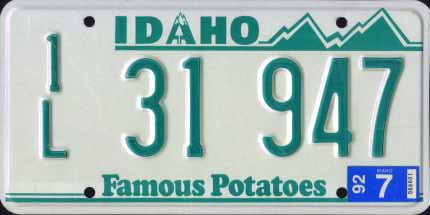 |
Idaho 1992 passenger issue. Yet another of these plates, this one has the same baseplate as the 1988 plate above, but features narrower dies. This plate comes from Latah county (#1L). These plates were also replaced with a new issue during the 1992 expiration cycle. |
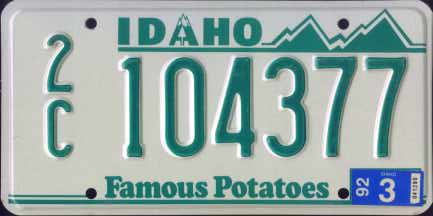 |
Idaho 1992 passenger issue. With the introduction of the new narrow die set, six-digit all numeric plates were issued in some counties after the initial serials exceeded 99,999. Previous to this base, overruns would have remained five digits, using a single alpha prefix. |
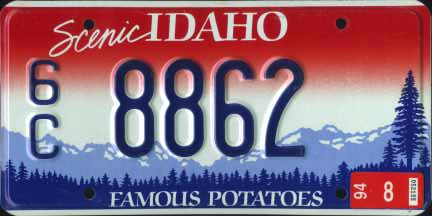 |
Idaho 1994 passenger issue. In 1991, this new baseplate was introduced. It is a modification of the popular Centennial optional plate, with a few minor changes. The word "Scenic" was added to the state name, and Famous Potatoes was retained as the slogan. This baseplate, slightly modified, is still the current Idaho issue as of today. This plate comes from Clearwater county, #6C. All 1974-91 green-on-white baseplates were replaced by these new plates in 1991-92. This plate design remained popular with ALPCA - the original Centennial plate won Plate of the Year in 1987, and this redesign was the winner in 1991. |
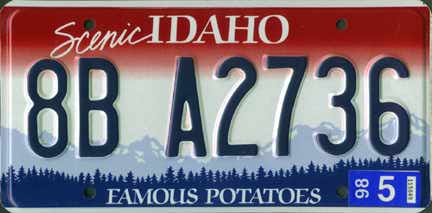 |
Idaho 1998 passenger issue. Current variation of the 1991 base, these plates were recently modified to include a full-sized county code prefix and a less gradual fade from red to white, both for better visibility. This plate also comes from county 8B, Bonneville. Plates later on in the series (beyond serial 99 999) include a single-alpha prefix in the serial. Recently, lower numbered serials are also appearing on this base with the full-size county code, suggesting that the state is either replacing older stacked-prefix plates with this style, or recycling inactive numbers, or both. |
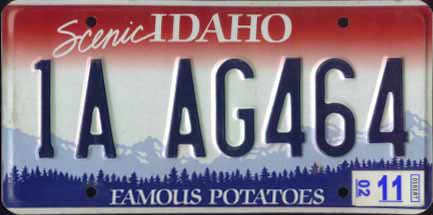 |
Idaho 2002 passenger issue. Extension of the current series, this example is from Ada county, which has overrun its allocation of all-numeric and single-alpha prefix serials and extended the series with a two-alpha format. |
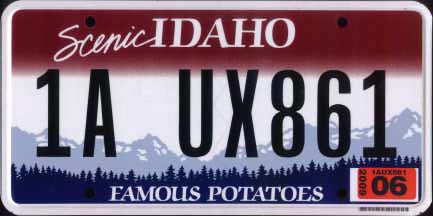 |
Idaho 2009 passenger issue. Early in 2008, Idaho changed their plate production to 3M's digital flat plate system, using the generic 3M serial font, in black instead of the previous dark blue. These flat plates also have slight tweaks to the background, most notably a full white border around the entire plate. The switch to flat plates was gradual depending on the county of issue, with the stock of embossed plates lasting longer in the smaller counties than in the larger. |
 |
Idaho 2012 passenger issue. Continuation of the series, as counties run through the available combinations of plates in the all-numeric, single-alpha and double-alpha serial prefixes, the next series in use is this format with the letter in the second serial position. |
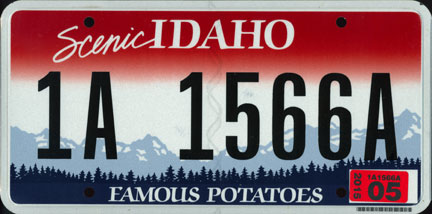 |
Idaho 2015 passenger issue. Yet another Ada county format, upon exhausting the 1A 1A234 format, the county started issuing plates with the alpha in the last position. |
Additional Idaho information provided by: Jeff Ellis
Return to U.S. Plates Index
© Copyright 1998-2022 David Nicholson. All Rights Reserved.
Last Modified 7/10/2017 (added 2015 plate).